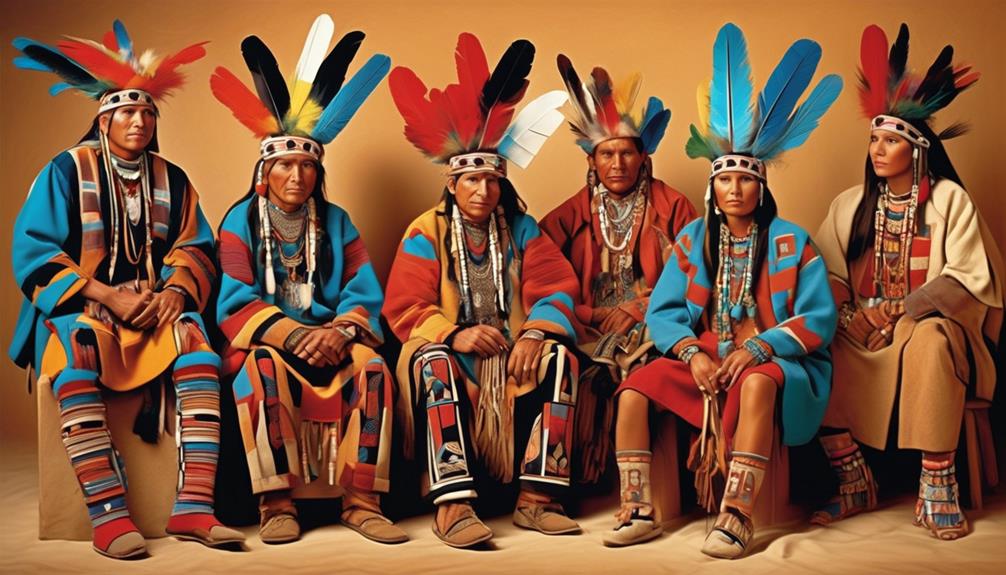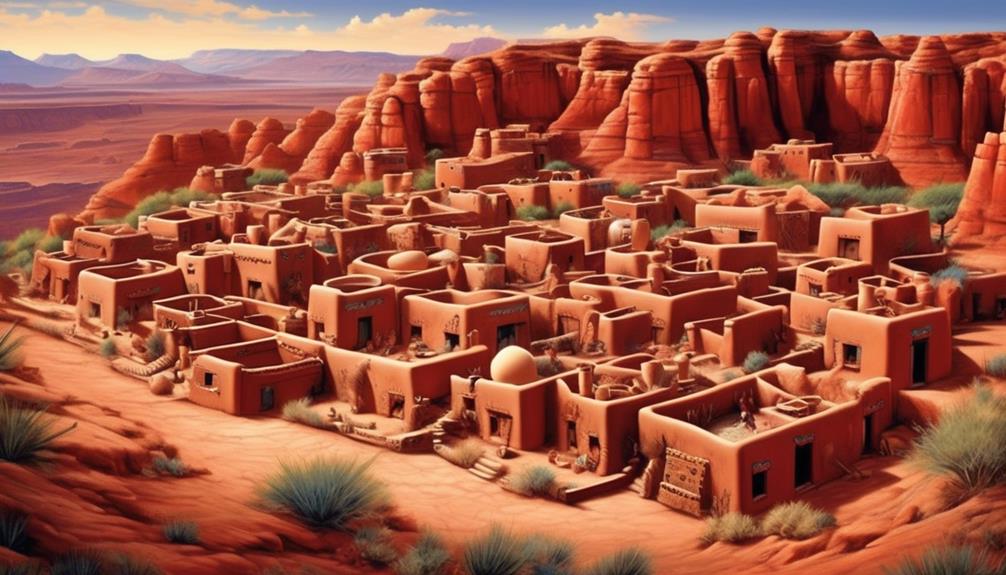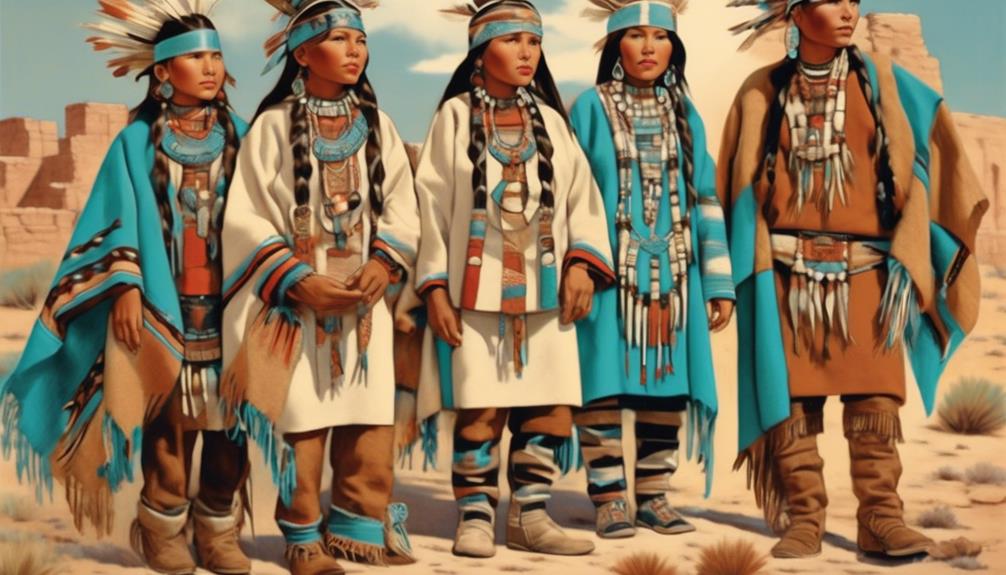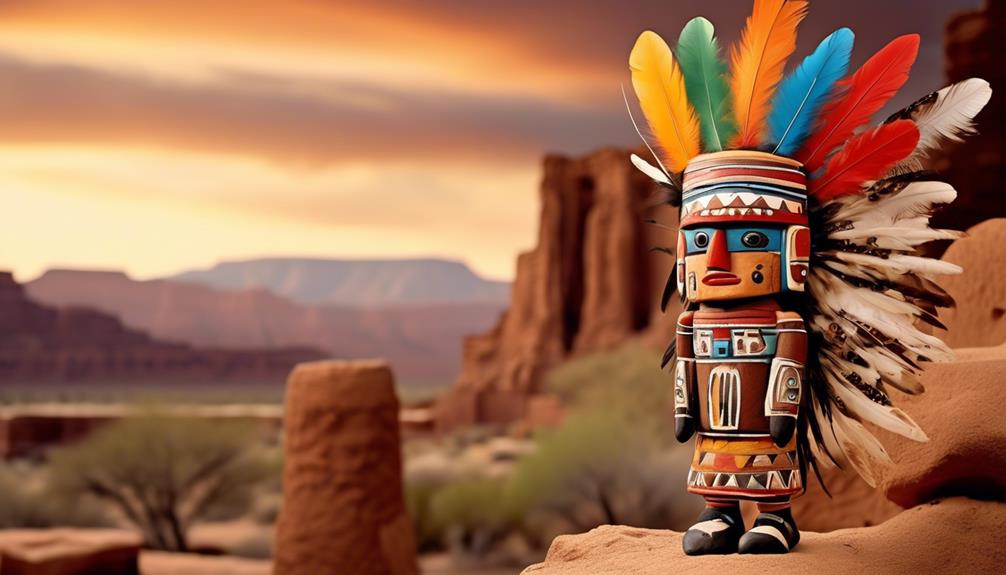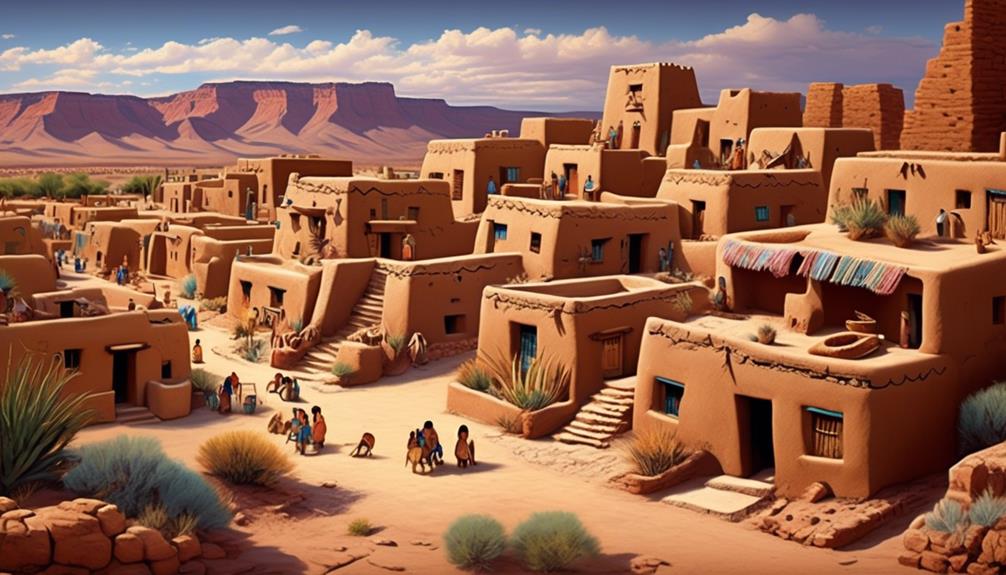Frequently, the fine details of traditional clothing are ignored, but were you aware that the Hopi tribe has a fascinating and distinctive history surrounding their attire?
From the symbolism woven into their garments to the materials used, there's much to explore.
The clothing of the Hopi tribe is not just about fashion, but a reflection of their deep cultural and spiritual significance.
Join us as we uncover the fascinating world of Hopi attire and discover the stories woven into each piece.
Key Takeaways
- Traditional Hopi clothing is characterized by rich colors, patterns, and symbolism, representing a connection to the earth, spirits, and ancestors.
- The intricate designs and patterns in Hopi attire convey deep spiritual and cultural significance, with specific colors and motifs representing elements of the natural world.
- Cotton and wool are central materials used in creating Hopi clothing, symbolizing the earth, agricultural roots, and interconnectedness with livestock and sustainability.
- Hopi fashion has evolved to integrate modern fabrics while preserving ancient designs, reflecting the dynamic interplay between cultural heritage and external influences.
Traditional Hopi Clothing
When discussing traditional Hopi clothing, we find a rich and vibrant tapestry of colors, patterns, and symbolism that reflect the deep cultural heritage of our people. Hopi clothing styles are steeped in tradition and hold significant meaning for our community. The traditional designs woven into our clothing are a testament to our connection to the earth, the spirits, and our ancestors. Each garment tells a story, preserving our history and values for future generations.
Our traditional clothing comprises a variety of styles, each serving a specific purpose within our cultural and ceremonial practices. From the vibrant and intricate katsina dances to the solemn rituals of the Powamu ceremony, our clothing plays a vital role in expressing our beliefs and honoring our traditions. The designs found on our garments often symbolize elements of nature, such as rain, clouds, and the sun, representing our reverence for the natural world.
As we continue to uphold our customs, the significance of traditional Hopi clothing remains a cornerstone of our identity. These timeless designs not only adorn our bodies but also serve as a visual language, communicating our enduring respect for our heritage and the world around us.
Symbolism in Hopi Attire
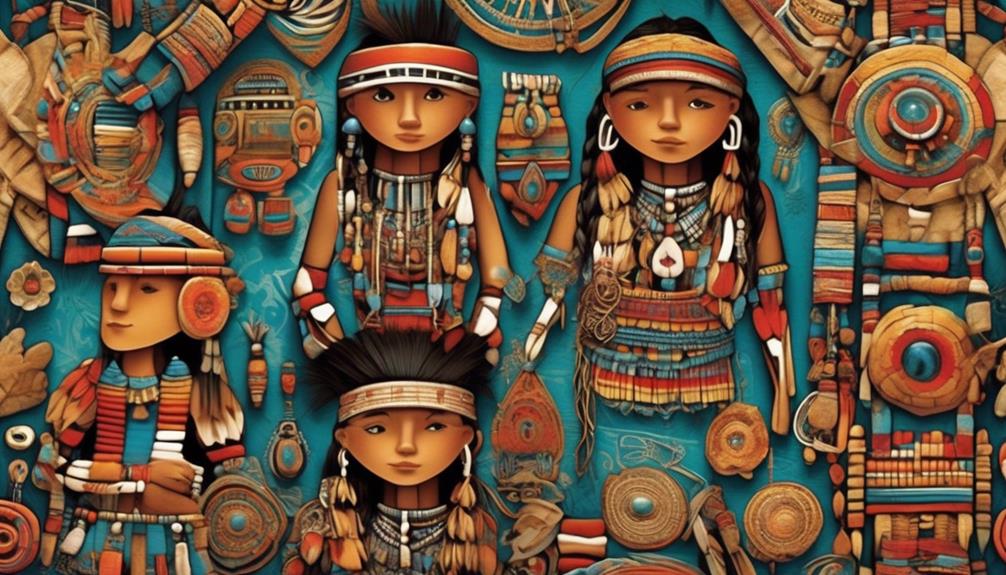
Symbolism imbues Hopi attire with profound cultural significance, weaving together ancestral wisdom and reverence for the natural world. Each element of traditional Hopi clothing carries symbolic meaning, serving as a powerful form of cultural representation.
The intricate designs and patterns found on Hopi garments aren't merely decorative, but rather convey deep spiritual and cultural significance. For example, the use of specific colors and motifs often represents elements of the natural world, such as rain, clouds, or the sun, reflecting the Hopi people's close connection to the environment and their agricultural way of life.
Additionally, the incorporation of symbols like corn, a staple crop for the Hopi, underscores the importance of agriculture and sustenance within their culture. Furthermore, the manner in which clothing is worn and adorned can also hold symbolic meaning, signifying one's role within the community or their participation in ceremonial events.
Materials Used in Hopi Clothing
The profound cultural significance of Hopi attire is reflected in the materials used, which are carefully selected to embody the tribe's traditions and connection to the natural world. Hopi textiles, such as cotton and wool, play a central role in the creation of traditional clothing. Cotton, known as 'pahos,' holds deep spiritual significance as it represents the earth and the Hopi people's agricultural roots. The use of wool, sourced from the sheep that the tribe has long raised, symbolizes the interconnectedness between the Hopi and their livestock, as well as the importance of sustainability within their community.
The process of creating Hopi textiles involves a rich tradition of craftsmanship, with techniques passed down through generations. The intricate patterns and designs woven into the fabrics often hold symbolic meanings, reflecting the tribe's history, values, and spiritual beliefs. Each garment is a testament to the skill and artistry of the Hopi people, as well as a representation of their profound respect for the natural world and the resources it provides.
Understanding the cultural significance of the materials used in Hopi clothing is crucial in appreciating the depth of tradition and spirituality woven into every garment. By recognizing the importance of these textiles, we honor the legacy and heritage of the Hopi tribe.
Evolution of Hopi Fashion
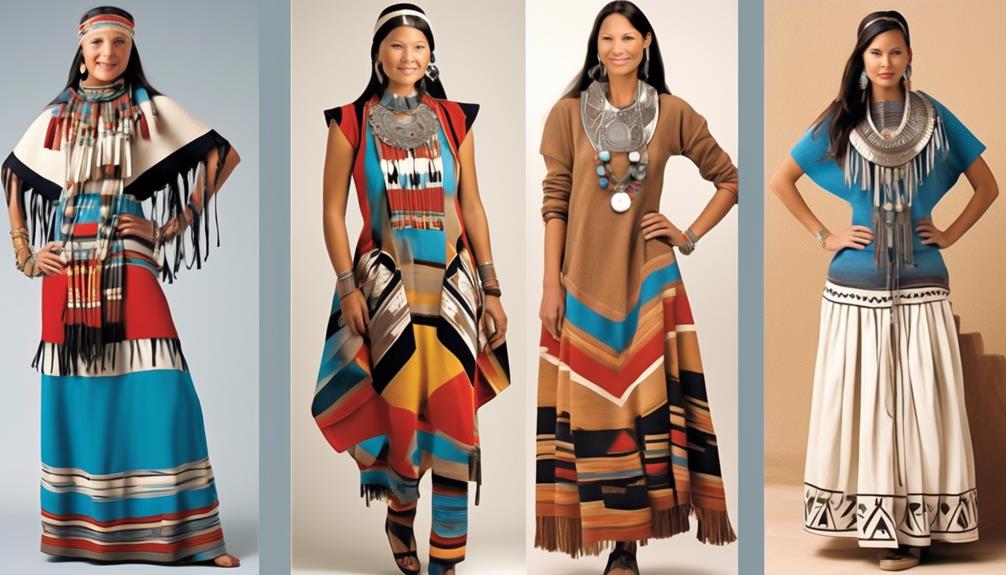
Over time, the clothing styles of the Hopi tribe have adapted and transformed in response to cultural changes and influences. The evolution of Hopi fashion has been shaped by various factors, including traditional practices and contemporary trends.
Here are some key aspects of the evolution of Hopi fashion:
- Incorporation of Modern Fabrics: The traditional clothing of the Hopi tribe, which was primarily made from cotton and animal hides, has gradually integrated modern fabrics such as wool and commercial textiles.
- Revival of Traditional Designs: While embracing modern influences, there's been a resurgence of interest in traditional Hopi fashion, with a focus on reviving and preserving ancient designs and techniques.
- Adaptation to Contemporary Lifestyles: The evolution of Hopi fashion has seen a shift towards clothing that meets the practical needs of modern life, while still maintaining cultural significance and symbolism.
- Influence of Global Fashion Trends: Like many indigenous cultures, the Hopi tribe has been influenced by global fashion trends, leading to a blend of traditional and contemporary elements in their clothing styles.
The evolution of Hopi fashion reflects a dynamic interplay between cultural heritage and external influences, resulting in a unique and evolving sartorial tradition.
Significance of Hopi Accessories
Accessories play a vital role in Hopi culture, complementing and enhancing the traditional clothing with symbolic and practical significance. Hopi jewelry, in particular, holds deep cultural meaning for the tribe. Each piece of jewelry, such as silver overlay bracelets, necklaces, and earrings, is intricately handcrafted and often adorned with traditional symbols representing elements of Hopi belief and heritage.
These accessories aren't merely decorative but are essential components of ceremonial and everyday attire, reflecting the wearer's spiritual and social standing within the community. For example, certain jewelry may be worn exclusively by individuals of a certain age or status, serving as a visible indicator of their role and responsibilities within the tribe.
Additionally, Hopi jewelry is often passed down through generations, symbolizing the continuity of traditions and the interconnectedness of the community. Therefore, these accessories hold immense cultural significance, serving as both personal adornments and powerful symbols of Hopi identity and heritage.
Frequently Asked Questions
How Did the Hopi Tribe Acquire the Materials Used in Their Clothing?
We acquired materials for clothing by trading, gathering, and crafting. Acquiring materials involved gathering plants, animal hides, and trading for textiles.
Clothing production was a community effort, with everyone contributing their skills. Maintenance was crucial, and we repaired and maintained our clothing to ensure durability.
Our traditional methods of acquiring materials and maintaining clothing reflect our strong connection to nature and the importance of sustainability within our tribe.
What Were the Specific Roles or Responsibilities of Individuals Within the Hopi Tribe Related to Clothing Production and Maintenance?
In our community, individual roles in clothing production and maintenance were vital.
Everyone contributed to gathering materials and creating garments using traditional methods. Some were skilled in weaving, while others were responsible for sourcing materials.
Maintenance involved repairing and caring for clothing to ensure durability.
Our collective efforts ensured that everyone had well-made garments that reflected our cultural traditions and values.
What Were the Traditional Methods of Dyeing and Decorating the Clothing of the Hopi Tribe?
Traditional dyeing methods and clothing decoration techniques were essential to the Hopi Tribe. The tribe utilized natural resources like plants and minerals to create dyes for their clothing, using techniques passed down through generations.
Intricate designs were applied using methods such as painting, embroidery, and appliqué. These traditions reflected our deep connection to nature and our commitment to preserving our cultural heritage.
How Did the Arrival of European Settlers and Missionaries Impact the Traditional Clothing of the Hopi Tribe?
The impact of colonization on the traditional clothing of the Hopi tribe was significant. European settlers and missionaries introduced new materials and styles, leading to cultural appropriation and changes in clothing practices.
These influences altered the traditional attire, challenging the preservation of our cultural heritage. The arrival of outsiders disrupted the integrity of our clothing customs, highlighting the complex and challenging relationship between the Hopi tribe and external forces.
What Are Some Examples of Traditional Hopi Accessories and Their Specific Cultural or Spiritual Significance?
Sure!
Traditional Hopi accessories hold great cultural significance and often have specific spiritual meanings. Some examples include the katsina dolls, which aren't just decorative but also represent spiritual beings and are used in ceremonies.
Another example is the wampum belt, a symbol of unity and peace. These accessories are deeply ingrained in our culture and play a vital role in our spiritual practices, connecting us to our heritage and beliefs.
Conclusion
In conclusion, the traditional clothing of the Hopi tribe is a beautiful reflection of their cultural heritage and spiritual beliefs.
From the symbolism in their attire to the materials used and the evolution of their fashion, Hopi clothing holds great significance.
As we continue to admire and learn about the Hopi tribe, their unique and meaningful accessories continue to captivate our fascination and admiration.
Mary is a passionate writer who brings creativity and a fresh perspective to our team. Her words have the power to captivate and inspire, making her an essential contributor to our content. Mary’s commitment to storytelling and dedication to promoting Indigenous culture ensures that her work touches the hearts of our readers. We’re fortunate to have her as part of our team.
